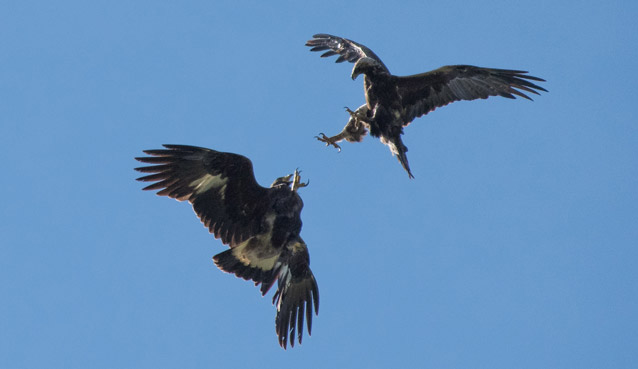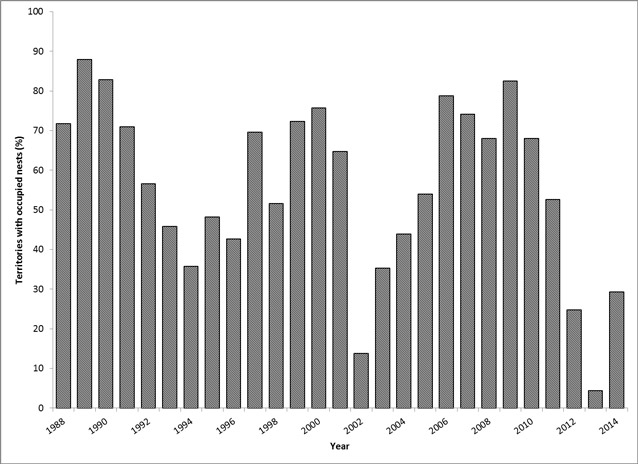
NPS Photo / Kent Miller
Golden Eagles are a vital sign of the NPS Central Alaska Monitoring Network. We have monitored territory occupancy and reproductive activities of Golden Eagles at 90 nesting territories in the northern foothills of the Alaska Range in Denali annually since 1988 using two standardized aerial surveys supplemented by additional ground surveys (McIntyre and Schmidt 2012). In 2015, we conducted the occupancy survey in late April and the production survey in mid-July using a R-44 helicopter.
Of the 90 territories monitored, 84 (93%) were occupied by a territorial pair of eagles. We documented occupied nests (those where eggs were laid) in 29% (n = 24) of the occupied territories. Twelve pairs raised at least one fledgling, resulting in a nest success of 50. Mean brood size was 1.0 and the number of fledglings per occupied territory was 0.15. Eagle reproduction in Denali in 2015 (as measured by territories with occupied nests) was similar to the past two years (see below), but remained low most likely due to the scarcity of snowshoe hare and other spring prey resources (McIntyre and Schmidt 2012).

In 2015, we also continued our efforts to identify the factors driving the decline in reproductive success of Denali’s Golden Eagles (see McIntyre and Schmidt 2012) including:
- Documenting the age structure of the territorial population;
- Identifying interactions between territorial eagles and apparent floaters (eagles that are not territorial holders);
- Assessing nest site fidelity and turnover rates at nesting territories (in cooperation with the USGS Alaska Science Center molecular genetics lab);
- Describing the year round movements of Denali Golden Eagles (in cooperation with the US Fish and Wildlife Service); and,
- Documenting changes in wintering habitat (in cooperation with West Virginia University).
Project scientists also continued efforts to protect occupied golden eagles nests from human disturbance (Fackler et al. 2014) and actively participated in ongoing research and management efforts for this species in North America in close cooperation with the US Fish and Wildlife Service and the US Geological Survey.
Our studies will continue in 2016 and include new fieldwork to tag a sample of territorial and juvenile Golden Eagles with highly precise telemetry units to identify migration routes, wintering areas, non-breeding areas and sources of mortality.
Contact: Carol McIntyre, National Park Service, 4175 Geist Road, Fairbanks, AK 99709. Email: Carol_McIntyre@nps.gov
Literature cited
Fackler, P.L., K. Pacific, J. Martin, and C. McIntyre. 2014. Efficient use of information in adaptive management with an application to managing recreation near golden eagle nesting sites. PLoS ONE 9(8): e102434. doi:10.1371/journal.pone.0102434.
McIntyre, C.L. 2016. Conserving migratory Golden Eagles in a rapidly changing world: what role will the NPS play? Alaska Park Science 14 (2).
McIntyre, C.L., and J.H. Schmidt. 2012. Ecological and environmental correlates of territory occupancy and breeding performance of migratory Golden Eagles Aquila chrysaetos in interior Alaska. Ibis 154: 124-135.
Last updated: July 6, 2016
